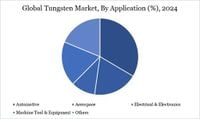Africa is emerging as a pivotal player in the global battery minerals race, holding vast reserves of essential resources such as cobalt, lithium, graphite, manganese, and rare earth elements. These minerals are critical to the accelerating shift toward clean energy technologies, electric vehicles (EVs), and renewable energy storage, positioning the continent at the heart of a global energy transformation.
The Democratic Republic of Congo (DRC) commands a commanding presence in this landscape, supplying over 70% of the world's cobalt—a metal crucial for high-density EV batteries. Cobalt’s role in preventing battery degradation and thermal runaway makes it indispensable for high-performance applications. However, the DRC’s cobalt mining sector faces challenges, with artisanal mining raising significant human rights and environmental concerns. Efforts to improve certification and monitoring are underway to address these issues.
Zimbabwe stands out as Africa's lithium powerhouse, hosting the continent's largest lithium reserves, including the Arcadia and Bikita deposits. These sites boast exceptionally high-grade spodumene concentrations, making them highly valuable for battery production. Mali is also making strides with its Goulamina project, poised to become one of the world's largest hard rock lithium mines. Other countries like Namibia and Ghana are exploring significant lithium deposits, collectively positioning Africa as a critical supplier in a market expected to grow exponentially with the surge in EV adoption globally.
Graphite, essential for battery anodes, is another mineral where Africa holds a strategic advantage. Mozambique's Balama mine is among the world's largest graphite producers, supplying high-quality natural graphite that constitutes nearly 95% of the anode material in lithium-ion batteries. Tanzania and Madagascar also possess substantial graphite reserves, with Madagascar's graphite known for its high carbon content and large flake sizes, commanding premium prices. Natural graphite from Africa offers environmental and cost advantages over synthetic alternatives, further enhancing the continent’s strategic importance.
South Africa contributes approximately 37% of global manganese ore, a critical component in lithium-manganese oxide and nickel-manganese-cobalt (NMC) battery chemistries dominating the EV market. Namibia and Tanzania are developing rare earth element deposits, vital for various battery chemistries and electric vehicle components. South Africa’s established mining infrastructure facilitates rapid scaling to meet growing demands, with beneficiation strategies increasingly focused on capturing more value domestically.
Historically, Africa’s mineral wealth has followed a familiar pattern: raw materials were extracted and exported with minimal local processing, limiting economic transformation. This colonial and post-colonial legacy has seen African nations capturing only a fraction—often 10-15%—of the final product value. However, the battery metals boom is challenging this status quo. Governments across the continent are implementing policies to retain more value through local processing and manufacturing, recognizing the battery revolution as a rare opportunity to reposition themselves in global value chains.
Zimbabwe, for example, has introduced restrictions on lithium ore exports, mandating some local processing before export. This policy has attracted investments in processing facilities, though balancing export controls with incentives remains a delicate task. Namibia is crafting frameworks to ensure domestic value addition for rare earths and other minerals, combining fiscal incentives with export levies on unprocessed materials. Meanwhile, the DRC and Zambia have formed a joint venture, supported by the African Development Bank, to develop a regional battery value chain focusing on cobalt and copper processing. These initiatives reflect a growing emphasis on structural economic transformation rather than mere extraction.
Yet, significant challenges persist. Infrastructure deficits, especially in energy and transportation, hamper industrial development. The DRC, despite its mineral wealth, has an electrification rate of only about 19%, complicating large-scale processing operations. Poor road networks, limited rail capacity, and port inefficiencies add logistical costs and delays. Addressing these gaps requires annual infrastructure investments estimated between $130 billion and $170 billion—far beyond current spending levels.
Technical capacity and investment needs also pose hurdles. Battery cell manufacturing demands specialized knowledge and capital, with facilities costing upwards of $2 billion. Developing such capacity domestically necessitates foreign partnerships, raising questions about control over strategic assets. Education and skills development are critical bottlenecks, requiring immediate training programs and long-term educational reforms to build a skilled workforce.
Policy uncertainties can deter investment. For instance, Zimbabwe’s lithium export ban initially paused some projects until regulatory details were clarified. Governments must balance short-term revenue needs from mining royalties with long-term industrial goals, a challenging political tightrope. Regional coordination under frameworks like the African Continental Free Trade Area (AfCFTA) offers a promising path to create complementary value chains, where countries specialize based on comparative advantage, enhancing collective competitiveness.
Looking globally, Indonesia’s nickel strategy offers instructive lessons. By banning nickel ore exports while incentivizing domestic processing, Indonesia attracted major investments in smelters and battery material production, tripling export value between 2014 and 2023 despite shipping less ore. This model combined export restrictions with active facilitation of downstream investment, a balance African policymakers are encouraged to emulate. Africa’s diverse mineral portfolio, unlike Indonesia’s nickel focus, allows for more complex and potentially resilient value chain development strategies.
Geopolitical dynamics further shape Africa’s battery mineral strategy. Western economies, wary of China’s dominance—controlling over 75% of the global battery supply chain and refining more than 60% of the world’s lithium—are actively seeking diversification. Initiatives like the US Inflation Reduction Act and the EU’s Critical Raw Materials Act incentivize supply chains outside China, elevating battery minerals to matters of national security. Competition among the US, EU, and China for African minerals strengthens African nations’ negotiating positions, offering opportunities for more favorable terms than in previous resource cycles.
Climate finance is another emerging lever. The global decarbonization push has unlocked funding for clean energy supply chains, benefiting African projects that meet stringent environmental and social governance (ESG) standards. Green bonds, sustainability-linked loans, and development finance institutions provide patient capital for value chain development that commercial investors might avoid. African producers meeting these standards can command premium prices, capitalizing on growing ESG-conscious markets. Advancements in battery recycling also complement primary resource strategies, promoting circular supply chains.
To maximize value, Africa needs clear, consistent policies balancing investor needs with national development goals. Transparent licensing, phased local content requirements, focused education programs, and strategic infrastructure investments are essential. Strengthened institutional capacities in geological surveys, mining regulation, and environmental monitoring will underpin effective governance. Regional integration through AfCFTA can foster coordinated value chains, shared infrastructure, and collective bargaining power, while environmental and social standards will enhance Africa’s appeal as a responsible supplier.
Emerging battery technologies present both risks and opportunities. Cobalt-free batteries, such as lithium iron phosphate (LFP) and sodium-ion types, threaten to reduce demand for cobalt, impacting the DRC’s strategic position. African countries must monitor these trends and diversify accordingly, supporting research partnerships to stay ahead of technological shifts.
Meanwhile, the global tungsten market is also gaining momentum amid rising demand from aerospace, defense, electronics, automotive, and mining sectors. Tungsten’s exceptional hardness, high melting point, and durability make it indispensable for hard metals, superalloys, and energy-efficient technologies. The market, valued at $5.16 billion in 2024, is projected to nearly double by 2032, driven by innovations like eco-friendly powder metallurgy and recyclable tungsten alloys with enhanced wear resistance and lower carbon footprints.
Major players such as ChinaTungsten, Umicore, Global Tungsten & Powders, and Nippon Tungsten are leading technological advancements, including nanostructured tungsten for quantum computing and additive manufacturing powders for high-temperature environments. Strategic mergers and acquisitions, like China Molybdenum’s stake in a Southeast Asian mine and Almonty Industries’ merger with a German refining firm, reflect efforts to localize processing and reduce reliance on China-centric supply chains.
Government initiatives further bolster the tungsten market. In July 2025, the US Department of Energy added tungsten to its list of strategic materials and launched programs to boost recycling from defense equipment, with Global Tungsten & Powders as a lead partner. Japan’s Ministry of Economy, Trade and Industry funded efforts to secure diversified tungsten imports, while partnerships with universities aim to develop advanced tungsten ceramics for nuclear fusion.
Meanwhile, geopolitical tensions between the US and China intensify the critical minerals contest. China’s dominance over refining and processing—controlling mines globally—has raised concerns, especially as it imposes export controls on gallium, germanium, antimony, and tungsten. The US is aggressively reshoring supply chains, supported by bipartisan policies and direct investments, highlighting critical minerals as a strategic front in technological and economic supremacy battles.
Leading mining companies are responding to these dynamics. Giants like BHP, Rio Tinto, Southern Copper, Glencore, and Vale are expanding production of copper, nickel, cobalt, and other battery metals, aligning with global clean energy demands. Saudi Arabia’s Ma’aden is diversifying beyond oil into critical minerals, while Fortescue is investing heavily in green energy and battery minerals, including rare earths. These companies’ strategic expansions underscore the growing importance of critical minerals in global supply chains.
In the United States, deep-sea mining is emerging as a frontier to counter China’s dominance in rare earths and battery minerals. U.S. territorial waters hold over 1 billion metric tons of polymetallic nodules, potentially boosting GDP by $300 billion and creating 100,000 jobs over the next decade. Companies like TMC The Metals Company and Impossible Metals are securing leases, while automakers like General Motors and Ford shift toward lithium-manganese-rich battery technologies, underscoring the strategic importance of these resources.
Despite challenges such as technology development for deep-sea mining machinery and regulatory uncertainties, the sector holds promise for reducing environmental impacts compared to land-based mining. International cooperation and innovation will be key to unlocking this potential.
As the global race for critical minerals accelerates, Africa’s rich resource base, combined with strategic policy reforms, regional integration, and sustainable practices, could transform the continent from a raw material supplier to a vital hub in the clean energy supply chain. The evolving tungsten market and deep-sea mining initiatives further illustrate the complex, interconnected nature of the minerals landscape shaping the future of energy, technology, and geopolitics.





